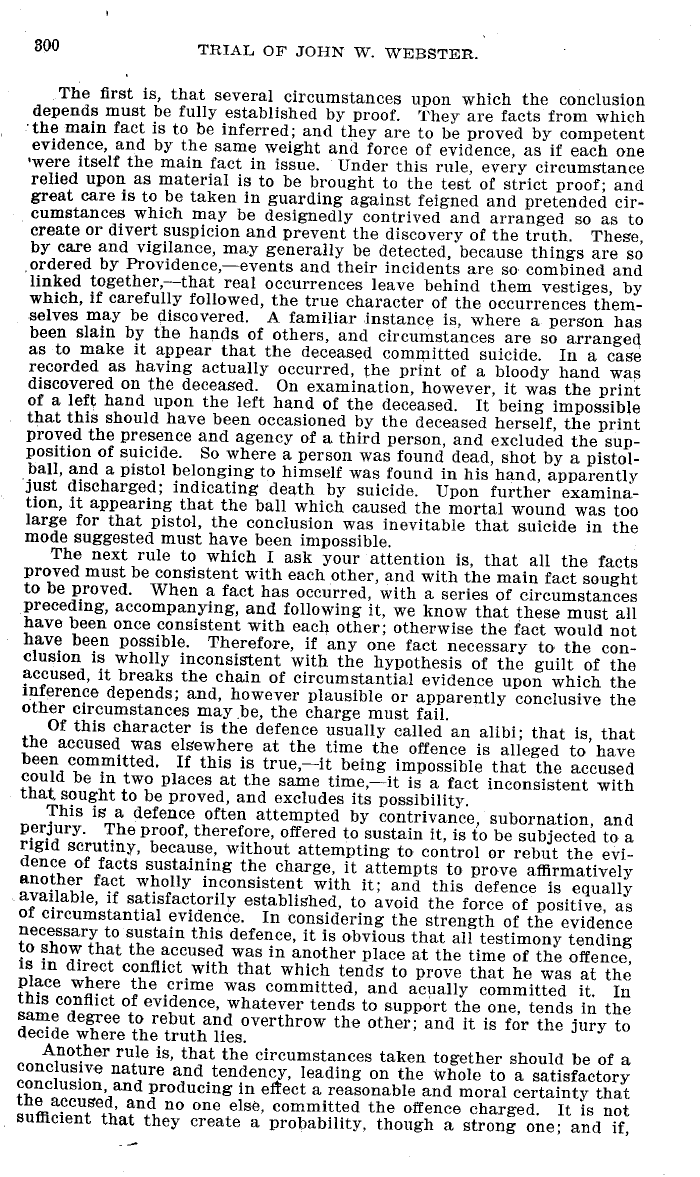|
300 ' TRIAL OF JOHN W. WEBSTER.
The first is that several circumstances upon which the conclusion
depends must be fully established by proof. They are facts from which
-the main fact is to be inferred; and they are to be proved by competent
evidence, and by the same weight and force of evidence, as if each one
were itself the main fact in issue. Under this rule, every circumstance
relied upon as material is to be brought to the test of strict proof; and
great care is to be taken in guarding against feigned and pretended cir-
cumstances which may be designedly contrived and arranged so as to
create or divert suspicion and prevent the discovery of the truth. These,
by care and vigilance, may generally be detected, because things are so
ordered by Providence,-events and their incidents are so combined and
linked together,-that real occurrences leave behind them vestiges, by
which, if carefully followed, the true character of the occurrences them-
selves may be discovered. A familiar instance is, where a person has
been slain by the hands of others, and circumstances are so arranged
as to make it appear that the deceased committed suicide. In a case
recorded as having actually occurred, the print of a bloody hand was
discovered on the deceased. On examination, however, it was the print
of a left hand upon the left hand of the deceased. It being impossible
that this should have been occasioned by the deceased herself, the print
proved the presence and agency of a third person, and excluded the sup-
position of suicide. So where a person was found dead, shot by a pistol-
ball, and a pistol belonging to himself was found in his hand, apparently
just discharged; indicating death by suicide. Upon further examina-
tion, it appearing that the ball which caused the mortal wound was too
large for that pistol, the conclusion was inevitable that suicide in the
mode suggested must have been impossible.
The next rule to which I ask your attention is, that all the facts
proved must be consistent with each other, and with the main fact sought
to be proved. When a fact has occurred, with a series of circumstances
preceding, accompanying, and following it, we know that these must all
have been once consistent with each other; otherwise the fact would not
have been possible. Therefore, if any one fact necessary to the con-
clusion is wholly inconsistent with the hypothesis of the guilt of the
accused, it breaks the chain of circumstantial evidence upon which the
inference depends; and, however plausible or apparently conclusive the
other circumstances maybe, the charge must fail.
Of this character is the defence usually called an alibi; that is, that
the accused was elsewhere at the time the offence is alleged to have
been committed. If this is true,-it being impossible that the accused
could be in two places at the same time,-it is a fact inconsistent with
that, sought to be proved and excludes its possibility.
This is a defence often attempted by contrivance, subornation, and
perjury. The proof, therefore, offered to sustain it, is to be subjected to
a
rigid scrutiny, because, without attempting to control or rebut the evi-
dence of facts sustaining the charge it attempts to prove affirmatively
another fact wholly inconsistent with it; and this defence is equally
available, if satisfactorily established to avoid the force of positive, as
of circumstantial evidence. In considering the strength of the evidence
necessary to sustain this defence, it is obvious that all testimony tending
to show that the accused was in another place at the time of the offence,
is in direct conflict with that which tends to prove that he was at the
place where the crime was committed, and acually committed it. In
this conflict of evidence, whatever tends to support the one, tends in the
same degree to rebut and overthrow the other; and it is for the jury to
decide where the truth lies.
Another rule is, that the circumstances taken together should be of a
conclusive nature and tendency, leading on the whole to a satisfactory
conclusion and producing in erect a reasonable and moral certainty that
the accused and no one else, committed the offence charged. It is not
sufficient that they create a probability, though a strong one; and if,
|

